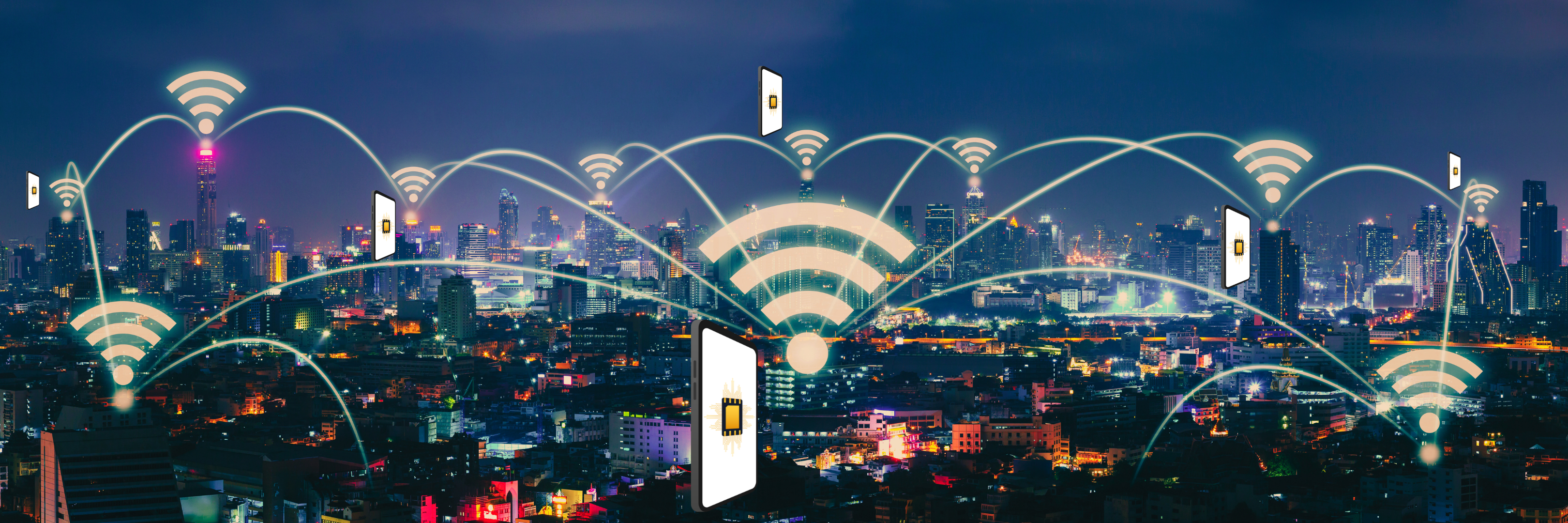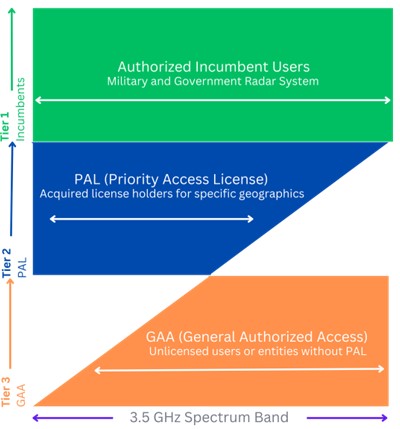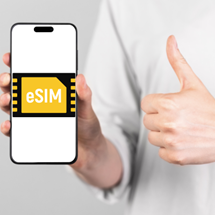Exploring CBRS: The Power of Shared Spectrum and Enhancing it with eSIM
Published on 22 August 2023 | 5 mins read.

Introduction:
Have you ever found yourself curious about the world of wireless connectivity and wondered what exactly CBRS is? Prepare to embark on an enlightening journey as we demystify the realm of CBRS (Citizens Broadband Radio Service) and unveil its captivating connection to eSIM-technology. In this blog, we'll delve into its intricacies and explore how this revolutionary shared spectrum is interwoven with the transformative power of eSIMs. Join us on this expedition as we uncover its untapped potential and harmonious synergy with eSIMs, two cutting-edge technologies that are redefining the landscape of wireless communication. Together, let's envision the future possibilities and embrace the boundless opportunities that this dynamic duo has in store for us.
What is CBRS?
CBRS, or Citizens Broadband Radio Service, is a wireless communication technology that enables shared access to a specific portion of the 3.5 GHz spectrum band, essentially in the USA, fostering innovative and efficient use of the available spectrum for various wireless-internet services.
It operates under a three-tiered spectrum sharing framework, enabling authorized users to efficiently access and utilize the available spectrum for various applications, including broadband internet, Internet of Things (IoT) devices, and other wireless services. The dynamic sharing of CBRS-spectrum creates opportunities for improved network capacity, enhanced coverage, and innovative use cases, making it a significant advancement in wireless communication technology.

The Power of Shared Spectrum:
The CBR Service introduces a three-tiered framework that allows multiple users to coexist harmoniously within the shared spectrum. At the top tier, authorized incumbent users like military and government radar systems enjoy priority access and protection. The second tier consists of Priority Access License (PAL) holders who have acquired licenses for specific geographic areas, granting them priority access in those regions. Finally, the General Authorized Access (GAA) tier welcomes unlicensed users or entities without PAL licenses to utilize the CBRS spectrum whenever it is available.
Unlocking the Potential of CBRS:
This technology has captured the attention of innovators and wireless enthusiasts due to its immense potential. By harnessing this shared spectrum, organizations can deploy a range of exciting applications. Private LTE networks provide reliable and secure connectivity for businesses, campuses, and venues. Industrial IoT solutions leverage CBRS to connect and manage smart devices in diverse industries. Fixed wireless access brings high-speed internet to underserved areas using CBRS-powered wireless connections. Additionally, neutral host networks enable seamless wireless coverage in venues and public spaces, enhancing the user experience for all.

The eSIM Connection:
You might be wondering, "How does CBRS relate to eSIM technology?" Well, eSIM (embedded SIM) serves as the digital counterpart of traditional physical SIM cards. While these two are separate concepts, they intertwine to enhance wireless experiences. eSIM-enabled devices, including smartphones and other connected devices, can seamlessly connect to CBRS networks. This union brings convenience, flexibility, and improved user experiences to those who rely on CBRS-enabled connectivity.
When you deploy CBRS; serving users with WI-FI or Cellular eSIM?
CBRS-deployments often leverage Wi-Fi networks indoors or in specific buildings where coverage is needed. Wi-Fi provides local connectivity and is commonly used within private premises, such as offices, campuses, or venues.
On the other hand, it also extends its coverage to outdoor areas and remote locations using cellular networks. In these scenarios, cellular eSIMs play a crucial role in providing connectivity to devices utilizing the CBRS-spectrum. By leveraging cellular eSIM technology, users can seamlessly connect to these networks in outdoor environments and areas where Wi-Fi coverage may be limited or unavailable.
This hybrid approach, combining Wi-Fi for indoor coverage and cellular eSIM for outdoor and rural areas, ensures comprehensive connectivity options for users accessing CBRS-services. It enables a seamless transition between different network technologies based on the user's location, optimizing the user experience and providing reliable connectivity in diverse settings.
There is another killer advantage of cellular eSIM over WI-FI is that it saves the cost of CPE and WI-FI router deployment and management, directly serving users with wireless connectivity with eSIM-supported devices in their hands. The CBRS operation and deployment just need to launch the eSIM RSP-as-a-Service to support this instead of using CPE and router etc. WI-FI devices.

CBRS and the Latest iPhone Capabilities:
Exciting advancements are on the horizon for the latest iPhones and the CBRS-ecosystem. With the upcoming iOS 17 release, Apple plans to introduce seamless switching between CBRS and public operator networks through geo-fencing. This innovative feature ensures a smooth transition between networks, optimizing connectivity for iPhone users in areas with CBRS-coverage.
The Evolution of iPhone and eSIM:
In the United States, the introduction of the iPhone 14 marked a significant shift towards eSIM-only devices. As more users embrace the convenience of eSIM technology, it becomes crucial to support additional functionalities such as seamless connectivity to CBRS networks. With CBRS supporting eSIM, iPhone 14 users can effortlessly leverage the benefits of both technologies, unlocking a world of possibilities for enhanced wireless experiences.In the United States, the introduction of the iPhone 14 marked a significant shift towards eSIM-only devices. As more users embrace the convenience of eSIM technology, it becomes crucial to support additional functionalities such as seamless connectivity to CBRS networks. With CBRS supporting eSIM, iPhone 14 users can effortlessly leverage the benefits of both technologies, unlocking a world of possibilities for enhanced wireless experiences.
Private 5G and CBRS:
In line with its commitment to providing cutting-edge connectivity experiences, Apple has been actively expanding support for private 5G networks. With CBRS being a prominent player in private LTE networks, this union presents a powerful combination. The integration of CBRS-support in the latest iPhones empowers businesses, campuses, and venues to deploy private 5G networks seamlessly, enabling faster, more reliable, and secure wireless connections.
Conclusion:
CBRS, eSIM, and the evolving capabilities of the latest iPhones are converging to shape the future of wireless communication. The introduction of eSIM-only devices like the iPhone 14 highlights the need for CBRS support to unlock its full potential. With seamless switching between CBRS and public operator networks, empowered by geo-fencing, iPhone users will experience uninterrupted connectivity. Additionally, the integration of CBRS support in iPhones further drives the adoption of private 5G networks, revolutionizing wireless experiences for various industries.
To delve deeper into the world of CBRS and eSIM, visit the following resources:
CBRS Alliance:https://alsd.com/content/cbrs-alliance
Apple's eSIM Technology:https://support.apple.com/en-us/HT212780
CBRS Deployment Guide:https://syedshan85.medium.com/deploying-a-network-with-cbrs-a-guide-d8f446be8f65
Step into the future of wireless connectivity with CBRS and eSIM, where seamless, secure, and enhanced experiences await. Stay informed, embrace innovation, and transform the way you connect in a wireless world powered by CBRS + eSIM.
Other interesting reads:

Bruce Chen
Co-Founder of Simlessly | Evangelist of RSP for Consumer and IoT | Specialist of IoT iSIM & eSIM | On a Mission driven by accelerating the revolution to eSIM & iSIM in a disruptive SaaS model